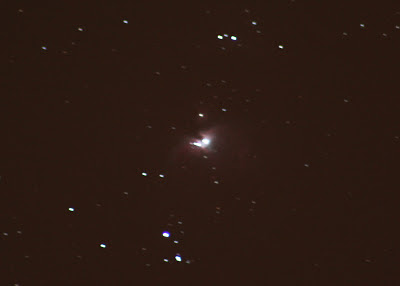To clean up my images, I'm trying a manual stacking technique in Photoshop that involves stacking 5 images into bundles, and then stacking the bundles. The first image is the background, followed by semi-transparent layers at 50, 33, 25, and 20 percent opacity.
That's how I created the image below! I used 10 total images (each 6 sec at ISO 1600), and stacked them by hand in Photoshop into 2 bundles of 5, and then stacked the bundles. The hardest part is lining up the nebula in each frame because as it moved toward the edge of my field of view there was some lens distortion. My next step is to learn how to use Deep Sky stacking software so I don't have to spend 30 minutes getting the frames to line up!
 |
| Final product stacked and aligned by hand in Photoshop |
Here is a side by side comparison of one 6-second frame next to the final product.
 |
| Single 6-sec exposure (L) and final product (R) |
Here is a crop of the Orion Nebula - my best deep sky photo yet!
 |
| Stack of 10 images each 6 sec ISO 1600 |

No comments:
Post a Comment